NVIDIA's GeForce GTX 560 Ti w/448 Cores: GTX 570 On A Budget
by Ryan Smith on November 29, 2011 9:00 AM ESTThe Test, Crysis, BattleForge, & Metro 2033
Yesterday NVIDIA launched their first 290 series beta driver - this was intended to be the launch driver for the GTX 560-448, but QA kept it held up longer than expected. In lieu of that we are using 285.62, the WHQL 285 series driver for the GTX 560-448.
For our look at performance we’ll be taking a look at our Zotac card both at NVIDIA’s stock speeds and at Zotac’s factory overclock. For power/temp/noise we’ll only be looking at Zotac’s card – the lack of a reference design means that temperatures and noise can’t be extrapolated for other partners’ cards.
| CPU: | Intel Core i7-920 @ 3.33GHz |
| Motherboard: | Asus Rampage II Extreme |
| Chipset Drivers: | Intel 9.1.1.1015 (Intel) |
| Hard Disk: | OCZ Summit (120GB) |
| Memory: | Patriot Viper DDR3-1333 3x2GB (7-7-7-20) |
| Video Cards: |
AMD Radeon HD 6870 AMD Radeon HD 6970 AMD Radeon HD 6950 NVIDIA GeForce GTX 580 NVIDIA GeForce GTX 570 NVIDIA GeForce GTX 560 Ti Zotac GeForce GTX 560 Ti 448 Cores Limited Edition |
| Video Drivers: |
NVIDIA GeForce Driver 285.62 AMD Catalyst 11.11a |
| OS: | Windows 7 Ultimate 64-bit |
As this is not a new architecture, we’ll keep the commentary thinner than usual. The near-GTX 570 specifications mean there aren’t any surprises with game performance.

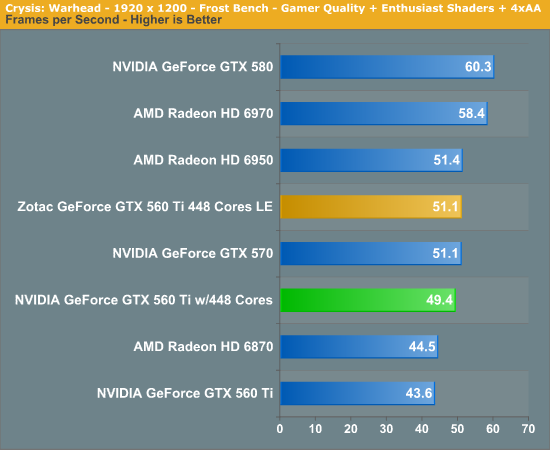
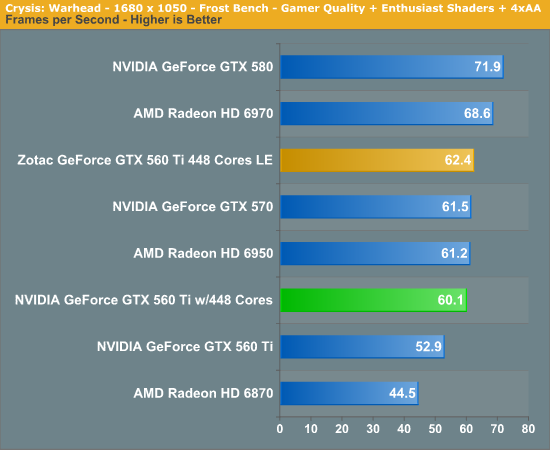
Starting as always with Crysis, at 2560 we can see that while GF100 cards perform decently at 2560, it’s really only the GTX 580 that stands a chance in any shader-heavy game. The GTX 560-448 in that respect is a lot like the GTX 560 Ti: it’s best suited for 1920 and below.
At 1920 and 1680 the GTX 560-448 is well ahead of its GF114-based namesake. As with the specs and architecture, the GTX 560-448 has more in common with the GTX 570 than it does the GTX 560 Ti. The end result is that the GTX 560-448 is just shy of 50fps at 1920, only a few percent off of the GTX 570. With Zotac’s overclock that closes the gap exactly, delivering the same 51.1fps performance. This goes to show just how close the GTX 560-448 and GTX 570 really are. NVIDIA may not want to call it a GTX 570 LE, but that’s really what it is.
Meanwhile compared to AMD’s lineup things are a little less rosy. The GTX 570 at launch was closer to competition for the Radeon HD 6970, but here the GTX 570 and GTX 560-448 are tied by or beaten by AMD’s cheaper 6950.

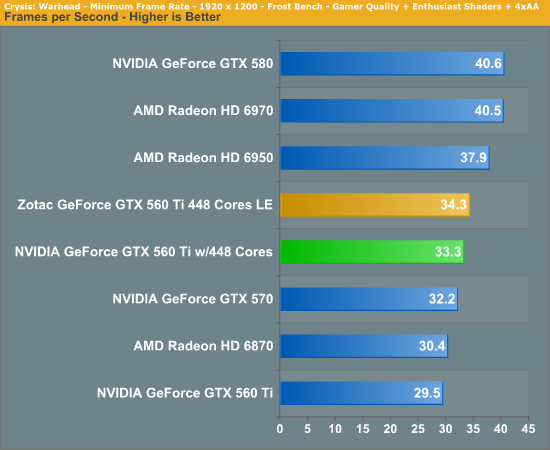

Looking at the minimum framerates we see the same trends. The GTX 560-448 is well above the GTX 560 Ti – by 13% at 1920 – but the 6950 is once again the victor.
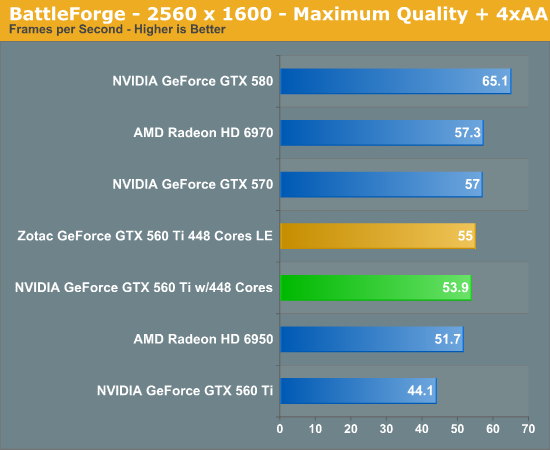


Moving on to BattleForge, we see the emergence of AMD and NVIDIA switching places based on the game being tested. BattleForge favors NVIDIA cards, and as a result the GTX 560-448 does quite well here, tying AMD’s more expensive 6970 at 1920. Zotac’s overclock further improves thing, but as BattleForge likes memory bandwidth, it can’t overcome the GTX 570’s 5% memory bandwidth advantage.


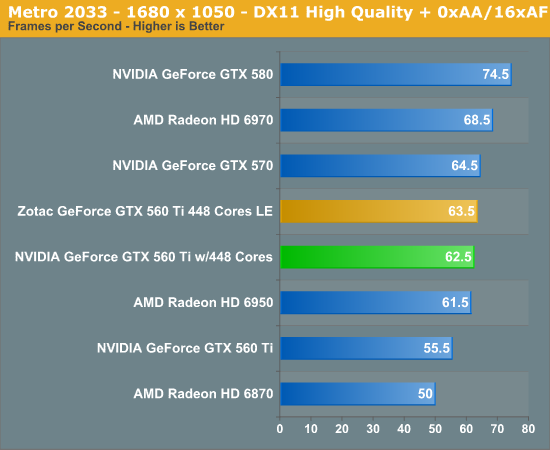
With Metro 2033 we see AMD and NVIDIA swap positions again, this time leaving AMD’s lineup with the very slight edge. This puts the 6950 ahead of the GTX 560-448 at 1920, even with Zotac’s overclock. Practically speaking however you’re not going to break 40fps on a single card without a GTX 580.










80 Comments
View All Comments
Transmitthis14 - Tuesday, November 29, 2011 - link
Many would ignore "Value" like that.I use Premier and Pshop, (cuda Acceleration) and also like the option of Physx with my Games when coded for.
So A 6950 then becomes a none option
Exodite - Wednesday, November 30, 2011 - link
Fringe benefits like those swing both ways though.I need three simultaneous display outputs, which render Nvidia options redundant in much the same way.
Looking strictly at price/performance, which is the metric most consumers would use in this case, the 2GB 6950 is indeed an excellent option.
grammaton.feather - Wednesday, November 30, 2011 - link
Oh really?http://www.overclock.net/t/909086/6950-shaders-unl...
I also agree with the CUDA argument. I have used Nvidia for years because of stereoscopic 3d support, more recently CUDA and PhysX and because I don't have driver crashes with Nvidia.
ATI may be better value for money at the cheap end of the spectrum, so long as u don't mind driver crashes.
A friend who used his high end PC for business had 170 plus ATI driver crashes logged by windows. I chose an Nvidia GPU for him and the crashing stopped.
rum - Wednesday, November 30, 2011 - link
I have had nothing but ATI cards since the 3870, and have NOT experienced these driver crashes you are speaking of.I use my computers for gaming and computer programming, and sometimes I do actually stress my system. :)
I am in the process of evaluating my video needs, as I do need a new video card for a new PC. I won't blindly go with ATI, I will EVALUATE all aspects and get the best card for the MONEY.
I don't need cutting edge, neither do most people, and we do evaluate things on most bang for the buck.
VoraciousGorak - Wednesday, November 30, 2011 - link
Funny, since I Fold on a GTX275, GTX460, and 9800GT on two different systems, and pretty often have NVIDIA's drivers lose their minds when finishing a WU, shutting down the system, or while simply processing a WU. I've tried multiple WHQL and beta drivers and settled with these being the least of my problems (the worst being total system unresponsiveness while Folding and a hard reset after a client stopped.) However, when I folded on my 6950 (granted, different client, but I Folded on it with the Beta client too) it never had a driver freakout, screen blank, or even a flicker when turning on or shutting off WUs.It seems to me that people that have major driver issues with AMD (not ATI anymore, by the way) cards are outliers, relative novices, and/or are using very outdated drivers or are recounting stories back from when the ATI 9700 series were new. I'm probably an outlier as well with my NVIDIA gripes, but characterizing a major modern GPU manufacturer with constant widespread driver issues or stating that any GPU is guaranteed to have problems is just silly.
silverblue - Thursday, December 1, 2011 - link
Oddly, those people who slate AMD are the ones who never ever seem to have an NVIDIA crash, or at least won't admit to one.Gorghor - Thursday, December 1, 2011 - link
I know this has no technical relevance, but I thought I'd share since my first reaction when I saw the article title, was "did I make a mistake buying an ATI6950?"For some reason I have been sticking to nVidia cards since the days of the Geforce 2. I made an exception with the ATI 9800 and although the performance was good back then, I had many problems with the drivers and really didn't approve of the catalyst control center.
When I upgraded my mainboard to the Sandy-bridge generation, I left my "old" GTX285 in the system and had several daily crashes related to the nVidia drivers (even after several months and driver updates).
About a month ago I decided it was time for me to upgrade the graphics. I wanted to stick to nVidia albeit the problems with my GTX285, but the price/performance ratio was just unacceptable when compared to AMD cards. I chose the ATI6950 2GB considering the same money would barely get me a GTX560.
I have to say I'm impressed. The performance is truly exceptional, even with no shader unlock, the catalyst interface has really matured over the years and my crashes are completely gone. So as far as I'm concerned, blindly going for nVidia is not an option anymore.
Golgatha - Tuesday, November 29, 2011 - link
what I take away from this review is the 560-448 is pretty much on par with a stock 570, but it will only be manufactured for roughly 2 months, and then be discontinued. Why would any gamer buy this card when they can get a superior card within $20 of this one and pretty much be guaranteed availability if they want to run SLI? Also, what's with the power connectors on the rear of the card. All of these long cards should situate those connectors on the top of the card.jigglywiggly - Tuesday, November 29, 2011 - link
I'd avoid it, you will probably be screwd with drivers in the long run.Samus - Tuesday, November 29, 2011 - link
As far as drivers and modern games go, people with ATI hardware have been having substantially more problems in Battlefield 3. Then the issue of microstutter arises which barely affects nVidia hardware, for what can only be presumed to be a ATI driver problem. Lastly, many people have experienced PowerPlay problems with Radeon 4000-5000 series cards running newer drivers due to clockspeed changes in-game, sometimes causing BSOD's, but always causing performance problems.nVidia has been, and always will be, the kind of drivers. The days of Mach64 still plague ATI's driver developement team. nVidia invented unified drivers and changed the game for the industry. They update their SLI profiles more than twice as often as ATI does for Crossfire, which alone shows their loyalty to their SLI users.
ATI has the hardware engineering team. That's clear. They can produce faster cards that use less power at lower prices. But you will NOT get superior drivers by a longshot.